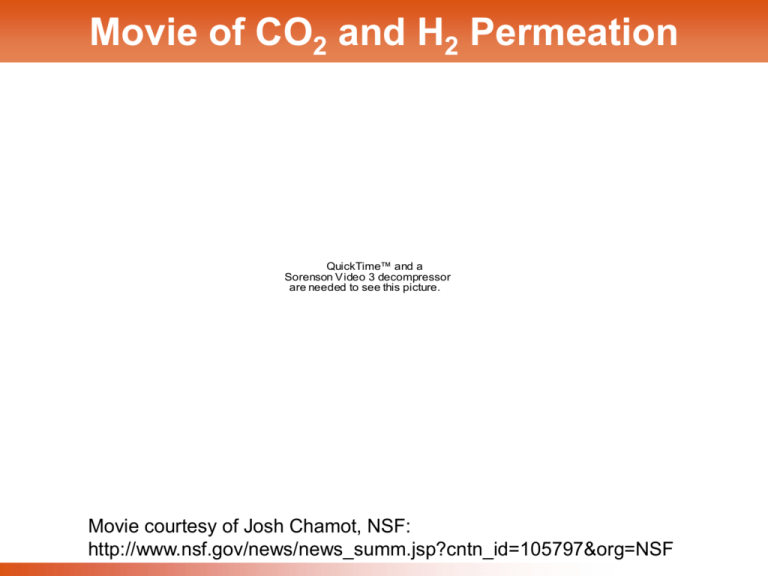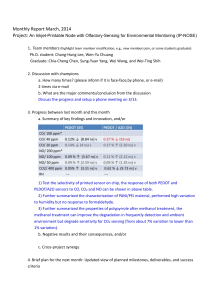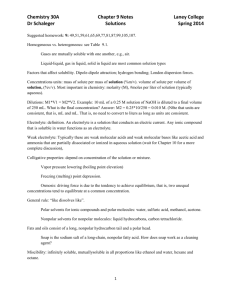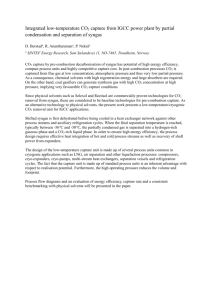Membrane Separations of Hydrogen
advertisement

Movie of CO2 and H2 Permeation QuickTime™ and a Sorenson Video 3 decompressor are needed to see this picture. Movie courtesy of Josh Chamot, NSF: http://www.nsf.gov/news/news_summ.jsp?cntn_id=105797&org=NSF 1 Membrane Hydrogen Purification: Classic (2) Recovered H2 H2 Oil Membrane (3) Fuel Gas Hydrotreater (1) Inerts Purge Oil/Gas Separator Treated Oil • H2/hydrocarbon separation • H2/CO ratio adjustment • NH3 purge gas recovery Photo from Air Liquide 2 Interest in Hydrogen • U.S. H2 production was 810 million kg/yr in 2003. (DOE) – Growth due to: • Low grade crude in refineries • Power source for fuel cells • Steam reforming of hydrocarbons accounts for 95% of the hydrogen produced in the U.S. (DOE 2003): CH 4 2H 2O CO2 4H 2 Fuel Cell Facility (PLUG) • Membranes may be useful for purifying H2: - Low capital costs - Compact size - Ease of operation DOE = http://www.eere.energy.gov/hydrogenandfuelcells/ PLUG = http://www.plugpower.com/technology/overview.cfm 3 Air Liquide Slides courtesy of Dr. Greg Fleming, UT Ph.D. ‘87 4 5 6 7 Fuel Cell Operation From Jim McGrath, Virginia Tech Source: H Power 8 Just what the environment needs from a car. Water. Hydrogen powered Fuel Cell vehicles only emit water. From Jim McGrath, Virginia Tech 9 H2 Purity Requirements for Fuel Cells A National Vision of America’s Transition to a Hydrogen Economy 2030 and Beyond, U.S. DOE, 2/2002. 10 Cost Estimates for H2 Production http://www.eere.energy.gov/hydrogenandfuelcells/pdfs/vision_doc.pdf 11 FutureGen "Today I am pleased to announce that the United States will sponsor a $1 billion, 10-year demonstration project to create the world's first coal-based, zero-emissions electricity and hydrogen power plant..." President George W. Bush February 27, 2003 12 FutureGen Concept 13 Gas Separations Using Membranes Current applications: • Air separation - mainly N2 enriched air • Natural gas treatment - acid gas removal • H2 separation - H2 from hydrocarbons, ammonia purge, syngas • Removal of vapors from mixtures with light gases (vapor separation) Advantages: • Low energy separation (no phase change) • Reliable (no moving parts) • Small footprint Drawbacks: • Incomplete separation (need higher selectivity) • Low chemical/thermal stability (need more resistant matls.) 14 Ideal Membrane Characteristics • High flux (high permeability, thin) • High selectivity • Tolerance to all feed components • Mechanical stability • Ability to be packaged in high surface area modules • Excellent manufacturing reproducibility, low cost 15 Hollow Fiber Module Contaminated Natural Gas (High Pressure) CO2- rich permeate (Low pressure) ~5,000 m2/m3 Upgraded Natural gas (High Pressure) D. Wang, et al., ACS Symp. Ser., v. 744, p. 107, 1999. 16 Natural Gas Purification U.S. Pipeline Specifications1: Amine Scrubber Component Specification CO2 <2% H 2O <120 ppm H 2S <4 ppm C3+ hydrocarbons 950-1050 Btu/ft3(STP) Dew Point -20C Inerts (N2, CO2, He, etc.) <4% Potential membrane applications: • Acid gas removal • N2 removal • Higher hydrocarbon removal • Dehydration Membrane Unit 1R.W. Baker, I.&E.C. Res., 41, 1393 (2002). 17 Gas Transport in Polymers: Solution-Diffusion Model J. Membr. Sci., 107, 1-21 (1995) 18 10 -6 CO 10 -7 H Permeability [cm C H 2 6 2 O 10 10 2 -8 He H 2 NH -9 10 -10 O N 3 10 10 -12 C H PDMS: 3 8 4 CH3 CO 2 n 2 2 N Si O 2 CH -11 CH3 PDMS, 35°C 2 CH 3 (STP) cm/(cm 2 s cmHg)] Characteristic Polymer Permeation Properties PSF: 4 PSF, 23°C SF CH 3 SO 2 6 CCl F 2 2 C Cl F 2 2 4 O C CH 3 O n 10 -13 50 100 150 200 3 V c [cm /mole] 250 300 19 Solubility and Diffusivity Characteristics PSF (STP)/(cm PDMS C2 H6 10 -2 10 -3 Diffusion Coefficient [cm 10 -1 3 Solubility [cm H 10 -5 N 2 O 2 /s] 10 -4 3 cmHg)] 10 0 2 CO He 10 10 C H 2 6 2 CF -6 4 3 8 10 -4 0 N2 O CH4 2 100 200 CO 2 300 T c [K] O 2 CO -8 N 2 2 CH 4 -9 PSF 10 -10 C H 4 10 C3 H8n-C4 H10 400 500 PDMS C F 10 -11 H2 C H 2 6C F 3 8 10 -7 10 2 CH 4 10 -12 10 100 V c [cm 3 /mole] 1000 B.D. Freeman and I. Pinnau, "Polymeric Materials for Gas Separations," in Polymeric Membranes for Gas and Vapor Separations: Chemistry and Materials Science, Edited by B.D. Freeman and I. Pinnau, ACS Symp. Ser. 733, pp. 1-27 (1999). 20 Materials Design Approach PA SA DA A/B • Traditional membrane materials S A DA S B DB • Glassy polymers • Designed to be strongly size-sieving • Low permeability • High selectivity due to high diffusion selectivity • Upon plasticization, selectivity decreases, sometimes strongly • H2 selective in H2/CO2 separations • Our approach • Rubbery polymers • Designed to be strongly solubility-selective • High permeability • Selectivity derives primarily from high solubility selectivity • Upon plasticization, separation properties can increase in some cases (CO2/H2) 21 Effect of Polar Groups in Liquid Solvents on CO2 Solubility and CO2/N2 Solubility Selectivity AN DMF DMS MeOH THF MAc PC TCM ACN THF 10 ACN 2 10 THF 2 CO 2 Solubility [cm 100 ACN CO /N Solubility Selectivity C6 100 3 (STP)/(cm 3 atm)] 25o C 1 1 10 15 20 25 30 Solvent Solubility Parameter [MPa 35 0.5 ] Lin and Freeman, J. Molecular Structure, 739(1-3), 57-74 (2005). O H3C C N Crosslinked Poly(ethylene oxide) [XLPEGDA] CH 2 CH C [O CH 2 CH 2 ] O 14 O C CH CH 2 OR O PEO Poly(ethylene oxide) diacrylate (PEGDA: Crosslinker) O CH 2 CH C [O C CH 2 CH 2 ] OR n O O R=CH3; poly(ethylene glycol) methyl ether acrylate (PEGMEA); n=8 R=H; poly(ethylene glycol) acrylate (PEGA); n=7 UV O C C C C C O C O PEO PEO PEO OR O C C C PEO O O C C C C O C O C C C C C O Mixed Gas Separation 102 10oC 1 10 2 CO /H 2 -20oC Upper Bound 35oC 100 10-1 10-2 10-1 100 101 102 103 CO Permeability [Barrer] 104 2 Lin, Haiqing, E. van Wagner, B.D. Freeman, L.G. Toy, and R.P. Gupta, “PlasticizationEnhanced H2 Purification Using Polymeric Membranes,” Science, 311(5761), 639-642 (2006). Mixed Gas CO2/CH4 Separation 50 35oC upper bound 6FDA-mPD 102 -20oC 4 30 PEGDA/PEGMEA-30 20 Pure 10 mixed 0 0 5 10 15 20 101 35oC 100 100 CO2 Partial Pressure [atm] PEGDA (crosslinker; 30wt %) CH2 CH C [ O CH2 CH2]13O C CH CH2 O O 10oC CA 2 CO /CH CO2/CH4 40 101 102 103 104 105 CO2 Permeability [Barrer] PEGMEA (monomer: 70 wt%) CH 2 CH C [O CH 2 CH 2 ]8OCH3 O Lin, Haiqing, E. van Wagner, B.D. Freeman, and I. Roman, “High Performance Polymer Membranes for Natural Gas Sweetening,” Advanced Materials, 18, 39-44 (2006). THANK YOU! 26






